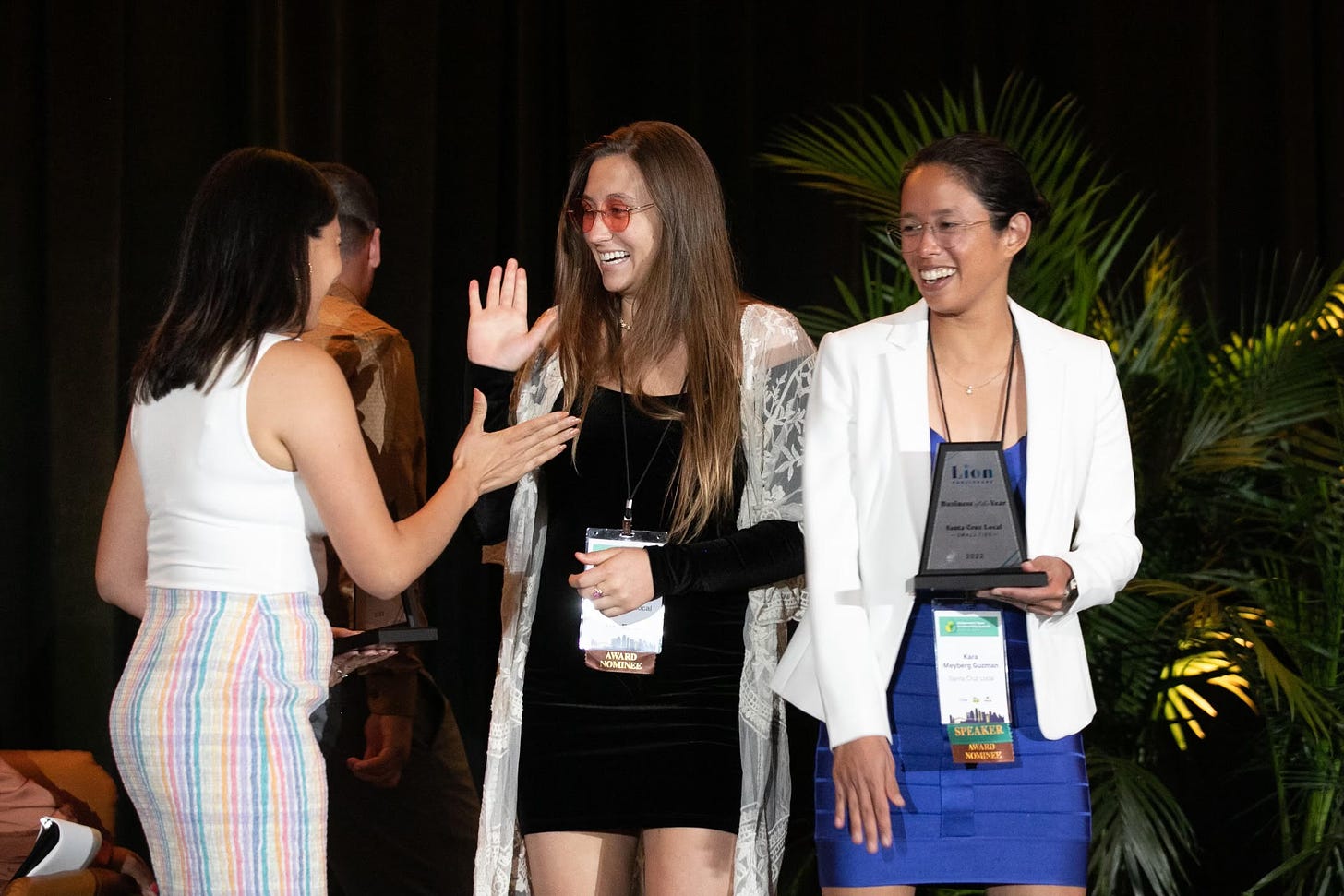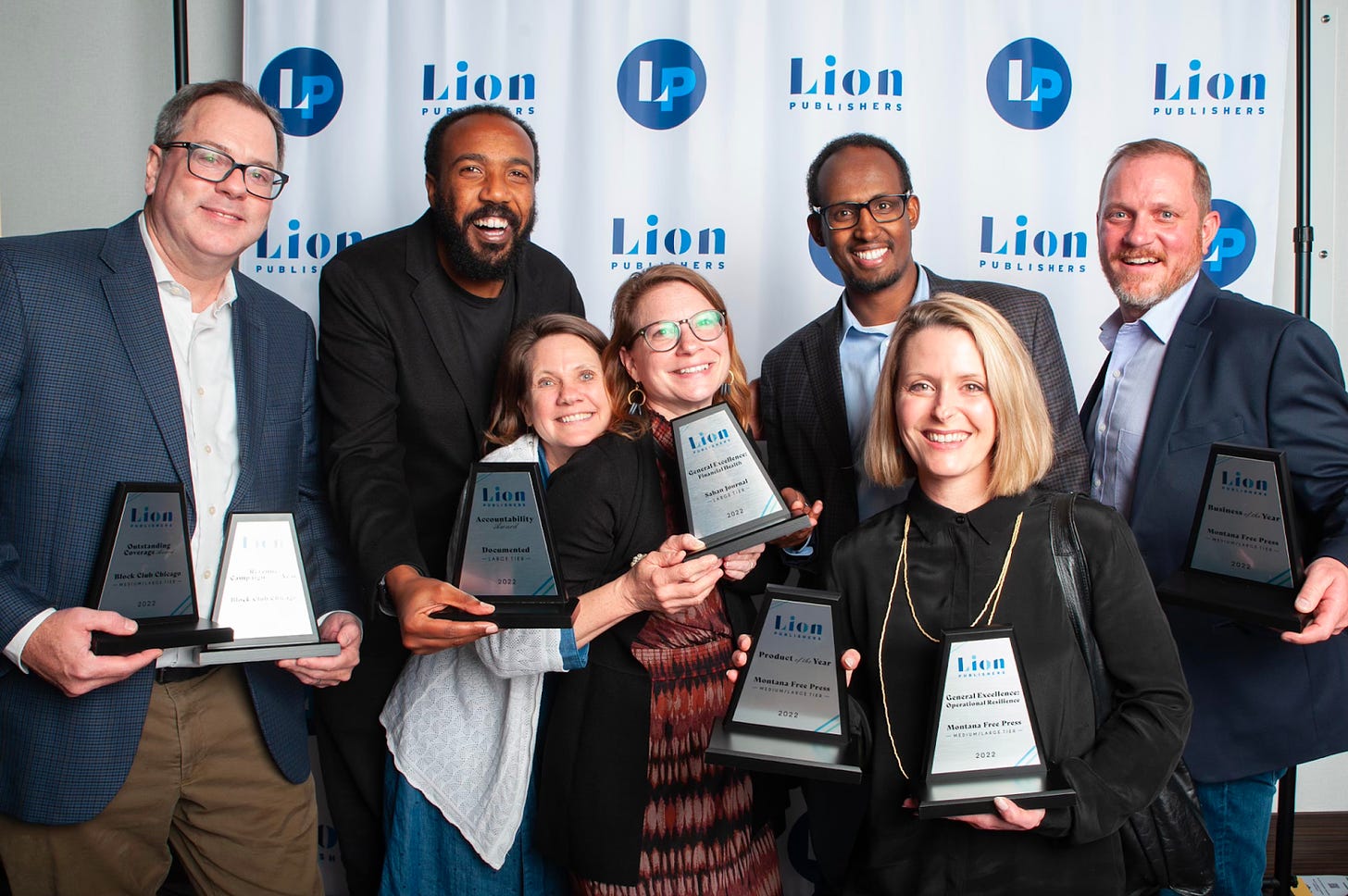In Austin, a sense of progress, positivity for local news rules the day
At INSS and the LION awards dinner, awards were handed out, tears were shed
I’ve been to a lot of journalism awards ceremonies in my lifetime. But I can’t remember one where you could feel the passion in the room as much as the LION Publishers Local Journalism Awards on Oct. 28 in Austin.
Twenty-nine awards were handed out that night, and the winners’ speeches reflected the rollercoaster of emotions these publishers have experienced along their often-difficult paths to the podium that night. There were a lot of tears, a heavy dose of humor and a lot of appreciation for the help many of the winners had received from other publishers in the audience. I’m not one for hyperbole, but this was a truly inspiring event. (And, I must note, the dinner emcees—Outlier Media’s Candice Fortman and LION’s Lisa Heyamoto—were fabulous, adding a ton of energy and laughs to the proceedings.)
The LION awards dinner was part of the inaugural Independent News Sustainability Summit (INSS), which Knight was proud to help fund. The conference—jointly produced by LION, News Revenue Hub and the RevLab at Texas Tribune—was focused on the sustainability of local journalism. Heck, there was even a Business of the Year award given at the dinner. Joshua Benton’s Nieman Lab piece on the awards captured the positive changes happening now in the nonprofit sector.

The INSS conference sessions I attended were excellent as well, and what impressed others I talked to was the heavy focus on tactics and operations over theory. Theories are wonderful, but operations pay the bills, so I was glad to hear that these time-starved publishers appreciated that real-world focus.
While we were thrilled to fund INSS, the credit for its success goes to the three organizations who approached us with the idea. LION, the Hub and the RevLab directly help hundreds of small, medium and large publishers seeking sustainability, and this event was just the latest example of these smart organizations finding a way to help publishers at scale.
There were so many impressive things about INSS, but maybe the most important was the vibe. For the past 20 years, journalism conferences haven’t exactly been the place to go if you were looking for positivity. INSS was different. There was a sense of progress being made and a belief that far more financial success for local news lies just around the corner. And, at Knight, we’ll keep doing everything we can to help accelerate this process.
Other news around the horn…
Policy
💵 Chicago pledges ad support to community media. Following in the footsteps of the Advertising Boost Initiative (ABI) in New York City, Chicago’s Mayor Lori Lightfoot signed an executive order that city agencies must spend at least 50% of their advertising budget on community media. That’s important in a city with 153 languages spoken, and many diverse communities served by small media outlets. Chicago’s agencies have only spent 18.8% of their ad money on community media for the past six years, according to the Chicago Independent Media Alliance. But that will change in a big way with this order. In NYC, the ABI helped bring in $15.6 million in ad money for community media last year, a whopping 82% of the print and digital ad budget for the city.
Elections
🗳️How three outlets put the voter first in election coverage. Today is Election Day, and what we most want is a break from the usual “horse race” coverage. Instead, three nonprofit news outlets have done things differently this cycle, trying to center coverage on voters and their concerns. Spotlight PA created many voter guides as well as a series laying out the competing policy visions for governor candidates. Injustice Watch in Chicago created a comprehensive guide to the 61 judges running in the election called “Check Your Judges.” And The 19th created “The State of Our Nation” using extensive polling of 20,000 women, particularly women of color and LGBTQ+ people.
Research
🎙️Public media is the local news “hiding in plain sight.” As nonprofit and even for-profit local news outlets develop memberships, merchandise and fundraising campaigns, they echo the success that public media stations have had for decades. And a recent study from the Tow Center for Digital Journalism found that those stations have the potential to become local media hubs in many towns. Of the top 123 public radio stations, revenues have increased from $678 million in 2009 to nearly $1 billion in 2020, with 40% coming from individual giving and 23% from underwriting. The number of reporters and volume of original content has grown alongside the revenues. While these larger stations could become leaders in local news in their markets (and some have even bought up newspapers, like WBEZ acquiring the Chicago Sun-Times), institutional stasis and slower moves to innovation and digital persist. Read the whole report here.
Maps
🌲 Agora helps map Oregon news ecosystem. Everyone is familiar with the “news deserts” map of disappearing newspapers. (And of course there’s our counterpoint from Knight, the Civic Bright Spots Map.) Now states are getting into the action as well, with the Agora Journalism Center at the University of Oregon completing an in-depth assessment of local news in Oregon, along with an interactive map. Their findings were stark: the state’s local newsrooms need more collaboration, more funding, and a state-wide innovation hub. “The evidence is increasingly clear that the civic health of communities is tied to the fate of local news,” wrote Regina Lawrence, research director at the Center. “Quality, accessible local news truly is a public good.”
🚠 Colorado project broadens view of news sources. A message board in central Colorado called PineCam. A Facebook page on high school sports called OTsportschek. An Instagram account on ski towns called i70Things. These are all part of the crazy quilt of local news providers on a new Colorado map that takes a much broader view of local news sources. Corey Hutchins led the collaborative process of creating the map, including two of his classes at Colorado College who interviewed people about where they get local news. “Non-traditional sources with varying missions, frequency, quality, and ownership are producing relevant regional news and information for audiences large and small—and on different platforms,” Hutchins wrote.
Impact
✨ How serving the Black community paid dividends in Akron. As part of a Table Stakes cohort, the Akron Beacon Journal realized they had a problem: They had a major gap in serving the large Black community. Their solutions? They created a series of 67 features on Black-owned businesses that generated 3,300 page views on average; looked deeply at racism as a public health issue; covered a failed freeway project that affected Black businesses and families; and even had a mobile newsroom initiative at a library in a predominantly Black neighborhood. The results were a 243% growth in digital subscriptions in those neighborhoods. “We’ve been reminded that writing quality stories about real people can pay dividends,” wrote the editors and reporters in Better News.
Upcoming Events 📅
Lenfest News Philanthropy Summit
Online
January 31—February 1, 2023
Knight Media Forum
Miami
February 21—23, 2023
Nashville
March 2—5, 2023
Austin
March 10—12, 2023
International Symposium for Online Journalism
Austin
April 14—15, 2023
Tweet of the Week

News @ Knight Credits
Written by Jim Brady, with Mark Glaser
Edited by Jessica Clark and Kara Pickman




